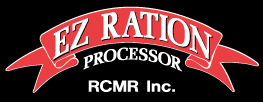Is blending feeds the answer for your operation?
With today’s uncertainty of rain and grass and the continuing increase in cost of winter supplement, producers are asking at what point does it become smarter to just feed a complete processed and blended ration?
This analysis will show the comparison between a winter grass supplement program and one that includes the use of an EZ Ration Hay Processor, calculating the benefits of blending hay feeds and showing how many more cows can be added without requiring additional acres as well as the difference in gross profit that could result from it.
Do not enter commas in your numbers.
Blending feeds can cut feed cost by 50% or more.
Blending feeds and feeding a total ration can sometimes be even cheaper than supplementing, plus you can usually run more cows.
Many of the larger operations have been feeding cows total blended rations through the winter months for years. However, it typically required a lot of equipment and man hours to do it efficiently. The EZ Ration Processor can now accomplish it with One Machine – One Man – and in One Operation, eliminating costly equipment and man hours. The simplicity with which the EZ Ration Processor blends feeds and changes the blend on the go now makes it possible for the smaller operations to feed total rations and increase cow numbers as well.
